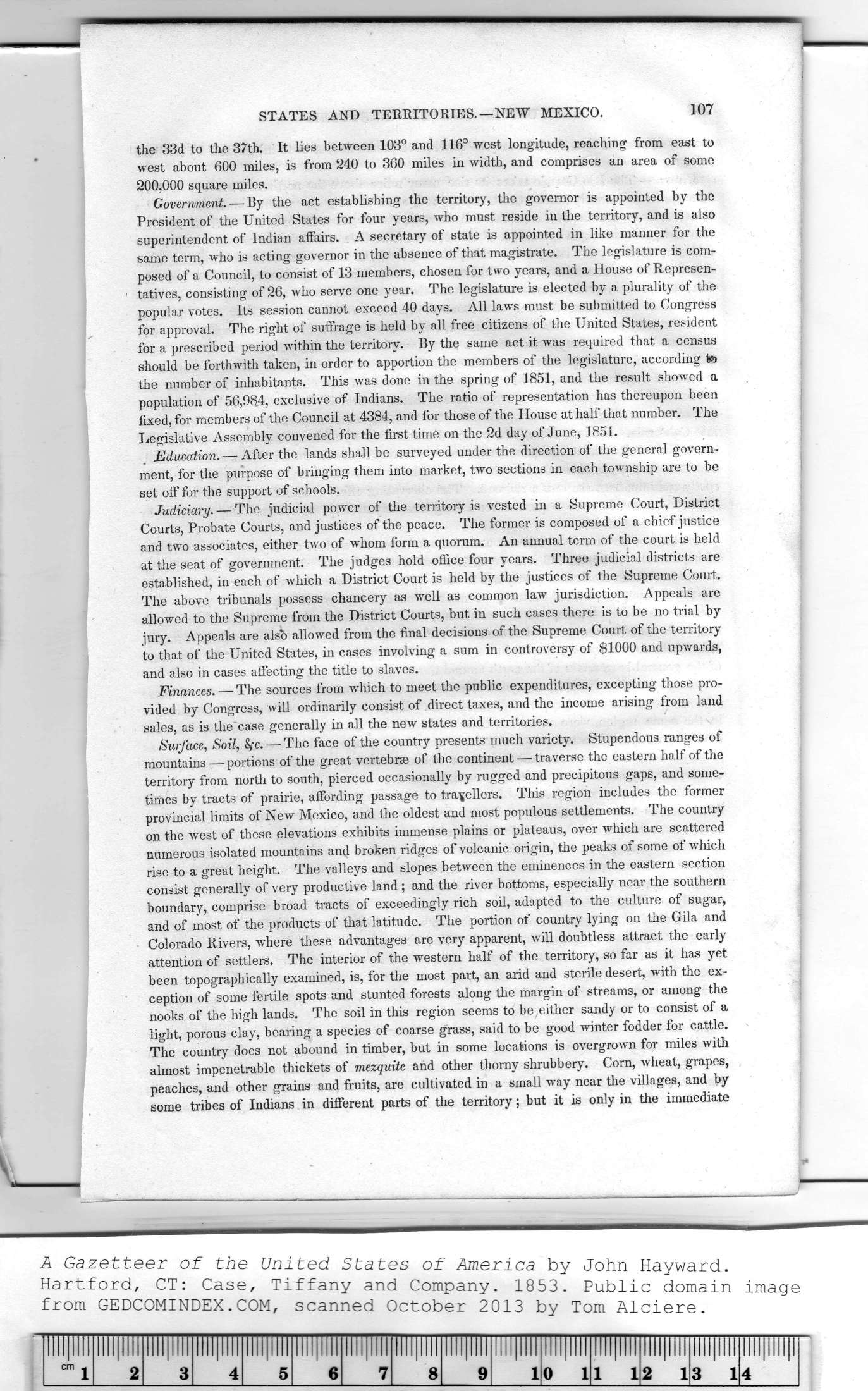|
|
Note: Ctrl and + increases the font size of the text below, Ctrl and - decreases it, and Ctrl and 0 resets it to default size.
STATES AND TERRITORIES.—NEW MEXICO. 107
the 33d to the 37th. It lies between 103° and 116° west longitude, reaching from east to
west about 600 miles, is from 240 to 360 miles in width, and comprises an area of some
200,000 square miles.
Government. — By the act establishing the territory, the governor is appointed by the
President of the United States for four years, who must reside in the territory, and is also
superintendent of Indian affairs. A secretary of state is appointed in like manner for the
same term, who is acting governor in the absence of that magistrate. The legislature is com-
posed of a Council, to consist of 13 members, chosen for two years, and a House of Represen-
tatives, consisting of 26, who serve one year. The legislature is elected by a plurality of the
popular votes. Its session cannot exceed 40 days. All laws must be submitted to Congress
for approval. The right of suffrage is held by all free citizens of the United States, resident
for a prescribed period within the territory. By the same act it was required that a census
should be forthwith taken, in order to apportion the members of the legislature, according to
the number of inhabitants. This was done in the spring of 1851, and the result showed a
population of 56,984, exclusive of Indians. The ratio of representation has thereupon been
fixed, for members of the Council at 4384, and for those of the House at half that number. The
Legislative Assembly convened for the first time on the 2d day of June, 1851.
Education. — After the lands shall be surveyed under the direction of the general govern-
ment, for the purpose of bringing them into market, two sections in each township are to be
set off for the support of schools.
Judiciary. — The judicial power of the territory is vested in a Supreme Court, District
Courts, Probate Courts, and justices of the peace. The former is composed of a chief justice
and two associates, either two of whom form a quorum. An annual term of the court is held
at the seat of government. The judges hold office four years. Three judicial districts are
established, in each of which a District Court is held by the justices of the Supreme Court.
The above tribunals possess chancery as well as common law jurisdiction. Appeals are
allowed to the Supreme from the District Courts, but in such cases there is to be no trial by
jury. Appeals are also allowed from the final decisions of the Supreme Court of the territory
to that of the United States, in cases involving a sum in controversy of $1000 and upwards,
and also in cases affecting the title to slaves.
Finances. — The sources from which to meet the public expenditures, excepting those pro-
vided by Congress, will ordinarily consist of direct taxes, and the income arising from land
sales, as is the case generally in all the new states and territories.
Surface, Soil, fyc. — The face of the country presents much variety. Stupendous ranges of
mountains —portions of the great vertebrae of the continent — traverse the eastern half of the
territory from north to south, pierced occasionally by rugged and precipitous gaps, and some-
times by tracts of prairie, affording passage to travellers. This region includes the former
provincial limits of New Mexico, and the oldest and most populous settlements. The country
on the west of these elevations exhibits immense plains or plateaus, over which are scattered
numerous isolated mountains and broken ridges of volcanic origin, the peaks of some of which
rise to a great height. The valleys and slopes between the eminences in the eastern section
consist generally of very productive land ; and the river bottoms, especially near the southern
boundary, comprise broad tracts of exceedingly rich soil, adapted to the culture of sugar,
and of most of the products of that latitude. The portion of country lying on the Gila and
Colorado Rivers, where these advantages are very apparent, will doubtless attract the early
attention of settlers. The interior of the western half of the territory, so far as it has yet
been topographically examined, is, for the most part, an arid and sterile desert, with the ex-
ception of some fertile spots and stunted forests along the margin of streams, or among the
nooks of the high lands. The soil in this region seems to be either sandy or to consist of a
light, porous clay, bearing a species of coarse grass, said to be good winter fodder for cattle.
The country does not abound in timber, but in some locations is overgrown for miles with
almost impenetrable thickets of mezquite and other thorny shrubbery. Corn, wheat, grapes,
peaches, and other grains and fruits, are cultivated in a small way near the villages, and by
some tribes of Indians in different parts of the territory; but it is only in the immediate
A Gazetteer of the United States of America by John Hayward.
Hartford, CT: Case, Tiffany and Company. 1853. Public domain image
|
